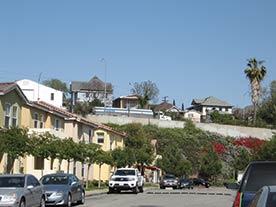
Photo by Rob Swatski CC By-NC
There is a narrative out there about how much of community development has lost its soul — community development has become too much about Development and not enough about Community, too concerned with efficient production of affordable housing and not concerned enough about social change, not engaged enough in creating a more caring, more connected, more just world. This narrative says that for community development to continue to be vital and relevant, it needs to return to its roots — its grassroots — and be more about organizing, more progressive, more explicitly about social and economic justice, less about Trump-esque deal making. Individual CDCs should be more neighborhood-based, with a deeper, more direct connection to their neighborhoods.
There is another narrative that community development is, and has been, too provincial, too focused on specific projects and individual neighborhoods and, more cynically, too focused on the needs of individual organizations. This narrative says that community development needs to be more big-picture oriented, more regional and metropolitan in scale, more about what is economically and environmentally sustainable in the metro region. Individual CDCs should still be place-based, but the unit of geography should be a region, not a neighborhood.
These two visions of the current state of and future revival of community development are somewhat in tension, but that’s more because they’re not talking to each other than because they are incompatible.
A Geographic Identity Crisis?
At the National Coalition for Asian Pacific American Community Development (National CAPACD), a national community development advocacy organization with over 100 members, we feel the multiple tensions within the community development field and view the current community development geographic identity crisis through a slightly different set of lenses.
Asian-American and Pacific Islander (AAPI) communities have our own histories with community development. One strand of these histories starts in the 1960s and ’70s when local community activists in Chinatowns and Japantowns across the country (largely in the San Francisco Bay Area, Los Angeles, New York City, Philadelphia, Boston, and Seattle) fought against urban renewal/redevelopment projects that threatened their neighborhoods. From these struggles, many of National CAPACD’s founding member organizations were born.
But the AAPI community is constantly growing, constantly being refreshed and changed through an influx of new immigrants from different places moving into new places. Many of our newer members come from communities and live in places that do not have the same community development history and infrastructure.
From the diverse experiences of our own member organizations, we have our own set of approaches and recommendations about the future of community development. These lessons arise from a culturally specific context, but we think they apply to the field more broadly.
We feel that both neighborhood and regional approaches are appropriate. Like the more grassroots position, we believe that community development organizations should serve/be responsive to a constituency/community in need. However, we feel that, depending upon the circumstance, the unit of geography for this constituency could appropriately be at a neighborhood or a regional level. And, while we are sympathetic to the metropolitan regionalist assumption that shared interests and values should generally trump intensely local self-interest, we are acutely aware that there are blind spots in all of our best intentions. Severe injustices can happen when minority community needs are overlooked or overridden, especially if they are perceived as being too locally focused. Regional approaches are important, but strong (empowered), smaller component communities are also essential to achieving equitable regions.
AAPI poor are one of the fastest growing poverty populations in the wake of the recent recession, with the fastest rate of growth in the native-born segment. Relative to their national concentration, AAPI poor are more concentrated in the neighborhood/census tract level than the poor of any other racial/ethnic group. Whether they be in historic inner-city core neighborhoods (e.g., the Chinatowns of old) or in relatively newer formations (e.g., the San Gabriel Valley in the Los Angeles region), the fact that AAPI poor are concentrated in identifiable clusters/neighborhoods tends to militate toward a neighborhood-based approach to serving them. Chinatown Community Development Center in San Francisco’s historic Chinatown neighborhood is one of the strongest examples of a member organization with an intensely neighborhood-based focus.
And yet, there are large numbers of poor AAPIs who now live in regions where there is growing AAPI poverty but not as strongly defined geographic concentrations (e.g., Atlanta; Washington, D.C.; Dallas; Houston; Riverside, Calif.). In these regions, member organizations like the Center for Pan Asian Community Services in Atlanta cast a more regional net.
Community development needs to do a better job working between these scales — to be engaged both at neighborhood and regional levels, emphasizing one over the other when the context/need dictates — not stuck in an either/or debate about rhetorical framing. National CAPACD member organization East Bay Asian Local Development Corporation, for example, has been able to apply a neighborhood-based approach in a variety of neighborhoods across a region.
Community development — even AAPI-oriented community development — also needs to be more consciously multicultural and multiracial. Poor AAPIs are almost as likely to be in a majority Hispanic neighborhood as in a majority AAPI neighborhood (approximately 11 percent in both cases) and even more likely to be in a neighborhood that has no single ethnic/racial majority (approximately one third of AAPI poor live in neighborhoods that are majority people of color but have no single population that accounts for over 50 percent).
We posit a vision of multiculturalism that is not postracial, in that we believe that race still matters. We should not downplay race/ethnicity as we work with other communities, but, instead, we should seek to build relationships and a common vision of the world that is based upon shared work and values. A National CAPACD member organization, the Little Tokyo Service Center CDC in Los Angeles, has taken a consciously multiracial/multicultural approach to its work at both the neighborhood level (e.g., organizing bridge-building activities for Japanese-speaking and Korean-speaking seniors in neighborhood affordable senior housing buildings) and at the regional level (e.g., co-founding a multiracial coalition of Los Angeles neighborhood-based CDCs and co-organizing a number of multiethnic AAPI collaboratives around various topics).
Similarly, National CAPACD works closely with the National Council of La Raza, National Urban League, National Association of Latino Community Asset Builders, and the National Alliance of Community Economic Development Associations on both policy advocacy and programmatic issues.
So, whether community development should become more local or more regional is not really an either/or question. We need to work at both levels. We need strong local communities engaged together in regional and local strategies, reflecting shared values and a shared agenda, within a multicultural and multiracial approach.





When you apply the neighborhood/regional issue to housing, the immediate issue that comes to mind for me are the rental rates set by HUD for the Section 8 and Housing Choice Voucher programs.
Because HUD’s “market rate” rents are determined by Metropolitan Statistical Area and not city/town or neighborhood, the rents can be quite high, depending on where the property is located, and disproportionately high when you consider the neighborhood in question. Where I live and work (Baltimore, Maryland), the MSA includes the wealthier suburbs, which skews the non-governement-assisted rents to a level where people who make a salary on the lower end of the presumed middle-class scale are paying well above the acceptable 25 to 30% of monthly income on rent.
Somehow we need a way to scale these rents to match the location of the property, and not take into consideration the greater region. Shoring up the lower-middle class is far less expensive than providing the assistance they’ll need when they can no longer afford necessities like housing and food.